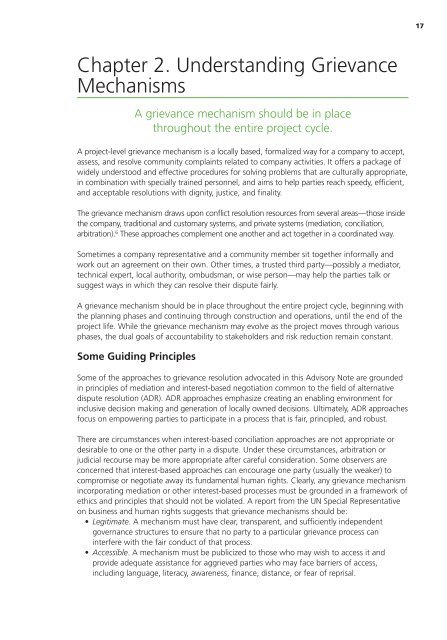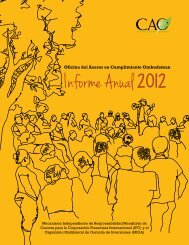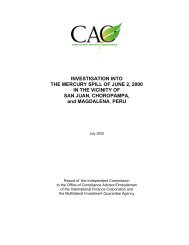A Guide to Designing and Implementing Grievance Mechanisms for ...
A Guide to Designing and Implementing Grievance Mechanisms for ...
A Guide to Designing and Implementing Grievance Mechanisms for ...
Create successful ePaper yourself
Turn your PDF publications into a flip-book with our unique Google optimized e-Paper software.
Chapter 2. Underst<strong>and</strong>ing <strong>Grievance</strong><br />
<strong>Mechanisms</strong><br />
A grievance mechanism should be in place<br />
throughout the entire project cycle.<br />
A project-level grievance mechanism is a locally based, <strong>for</strong>malized way <strong>for</strong> a company <strong>to</strong> accept,<br />
assess, <strong>and</strong> resolve community complaints related <strong>to</strong> company activities. It offers a package of<br />
widely unders<strong>to</strong>od <strong>and</strong> effective procedures <strong>for</strong> solving problems that are culturally appropriate,<br />
in combination with specially trained personnel, <strong>and</strong> aims <strong>to</strong> help parties reach speedy, efficient,<br />
<strong>and</strong> acceptable resolutions with dignity, justice, <strong>and</strong> finality.<br />
The grievance mechanism draws upon conflict resolution resources from several areas—those inside<br />
the company, traditional <strong>and</strong> cus<strong>to</strong>mary systems, <strong>and</strong> private systems (mediation, conciliation,<br />
arbitration). 6 These approaches complement one another <strong>and</strong> act <strong>to</strong>gether in a coordinated way.<br />
Sometimes a company representative <strong>and</strong> a community member sit <strong>to</strong>gether in<strong>for</strong>mally <strong>and</strong><br />
work out an agreement on their own. Other times, a trusted third party—possibly a media<strong>to</strong>r,<br />
technical expert, local authority, ombudsman, or wise person—may help the parties talk or<br />
suggest ways in which they can resolve their dispute fairly.<br />
A grievance mechanism should be in place throughout the entire project cycle, beginning with<br />
the planning phases <strong>and</strong> continuing through construction <strong>and</strong> operations, until the end of the<br />
project life. While the grievance mechanism may evolve as the project moves through various<br />
phases, the dual goals of accountability <strong>to</strong> stakeholders <strong>and</strong> risk reduction remain constant.<br />
Some Guiding Principles<br />
Some of the approaches <strong>to</strong> grievance resolution advocated in this Advisory Note are grounded<br />
in principles of mediation <strong>and</strong> interest-based negotiation common <strong>to</strong> the field of alternative<br />
dispute resolution (ADR). ADR approaches emphasize creating an enabling environment <strong>for</strong><br />
inclusive decision making <strong>and</strong> generation of locally owned decisions. Ultimately, ADR approaches<br />
focus on empowering parties <strong>to</strong> participate in a process that is fair, principled, <strong>and</strong> robust.<br />
There are circumstances when interest-based conciliation approaches are not appropriate or<br />
desirable <strong>to</strong> one or the other party in a dispute. Under these circumstances, arbitration or<br />
judicial recourse may be more appropriate after careful consideration. Some observers are<br />
concerned that interest-based approaches can encourage one party (usually the weaker) <strong>to</strong><br />
compromise or negotiate away its fundamental human rights. Clearly, any grievance mechanism<br />
incorporating mediation or other interest-based processes must be grounded in a framework of<br />
ethics <strong>and</strong> principles that should not be violated. A report from the UN Special Representative<br />
on business <strong>and</strong> human rights suggests that grievance mechanisms should be:<br />
• Legitimate. A mechanism must have clear, transparent, <strong>and</strong> sufficiently independent<br />
governance structures <strong>to</strong> ensure that no party <strong>to</strong> a particular grievance process can<br />
interfere with the fair conduct of that process.<br />
• Accessible. A mechanism must be publicized <strong>to</strong> those who may wish <strong>to</strong> access it <strong>and</strong><br />
provide adequate assistance <strong>for</strong> aggrieved parties who may face barriers of access,<br />
including language, literacy, awareness, finance, distance, or fear of reprisal.<br />
17





